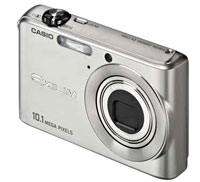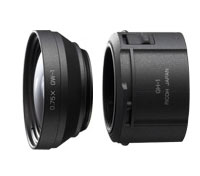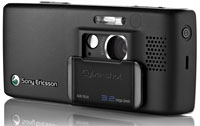 Before you start reading this review, let’s get a few things straight.
Before you start reading this review, let’s get a few things straight.
If you’re looking for an auto everything camera with a zillion hand-holding scene modes, big pretty icons and more wizards than a cauldron convention, this isn’t the camera for you.
If you’re after a camera with a ginormous zoom able to sweep in and capture the delicate fluttering of a wasp’s wings from 300 yards, move on.
 And if you like your cameras to look mean’n’lean with big shiny lenses, all-swivellin’, flip-out LCD screens with hi-tech add-ons like optical image stabilisation and bleeping bells’n’whistles, walk on by.
And if you like your cameras to look mean’n’lean with big shiny lenses, all-swivellin’, flip-out LCD screens with hi-tech add-ons like optical image stabilisation and bleeping bells’n’whistles, walk on by.
You want to zoom in to a scene? Well, get walking because there’s no zoom at all, only a fixed wideangle lens.
Need to take a picture in a complex lighting situation? Then come back when you’ve learnt some photography basics because there’s no dial-full of scene modes to fall back on.
Less is more
Unlike any other digital compact we can think of, the Ricoh GR Digital is an 8 megapixel digital camera that seems to be unique in selling itself on having less whiz-bang features than its competitors.
 Although this approach may not appeal to the point’n’shoot brigade, for enthusiasts fed up with the endless button pushing and dial spinning that comes with most compact digicams, this camera is a revelation.
Although this approach may not appeal to the point’n’shoot brigade, for enthusiasts fed up with the endless button pushing and dial spinning that comes with most compact digicams, this camera is a revelation.
Based on the legendary Ricoh GR1 35mm film camera, the GR is a no-holds barred landscape/street photographer’s dream offering a fast 28mm f2.4 lens, beautiful handling and dedicated manual controls giving full control over exposure.
An optional wide angle adapter provides an incredible, super-wide 21mm (film equiv) view – perfect for landscape/architectural photographers – although the removable lens mount ring looks a prime candidate to be promptly lost.
 Sadly, there’s no built in optical viewfinder, although the big 2.5″ LCD 210k pixel screen performed well in bright light and can also display a live histogram display.
Sadly, there’s no built in optical viewfinder, although the big 2.5″ LCD 210k pixel screen performed well in bright light and can also display a live histogram display.
Pro users (with deep pockets) may be tempted to shell out for the optional Optical Viewfinder – this clips onto the hotshoe socket and offered the brightest view we’ve ever seen on a compact digicam.
Handling
Despite its non-bling, ultra-basic looks (one person mistook the £400 camera for a disposable!) when you pick up the Ricoh you can instantly feel the class – it’s tough, feels great, it’s just the right size in the hands with all the controls exactly where you want them to be.
 The camera is one of the smallest digital cameras with ultra-wide angle lens, and fits easily in a pocket, measuring 107 x 25 x 58 mm (WxDxH).
The camera is one of the smallest digital cameras with ultra-wide angle lens, and fits easily in a pocket, measuring 107 x 25 x 58 mm (WxDxH).
Ricoh’s menu system proved very intuitive, with clearly labelled tabs guiding users through the various options available and the paper manual was one of the better ones we’ve read – and thankfully didn’t come in five hundred obscure languages.
The camera takes a proprietary lithium-ion rechargable battery which gave a reasonable battery life of around 230 shots, while Ricoh usefully include the option to use 2 AAA batteries in an emergency.
Although these are likely to pack in after only 25 shots or so, they could be a life saver when batteries fail unexpectedly.
Exposure and shooting options
Although there is one ‘Auto’ mode, to appreciate this camera you’ve got to switch to the advanced modes: Program Shift, Aperture Priority and Manual (there is a scene mode, but this only has a voice recording option and a setting for capturing text).
In Aperture Priority, turning the dial at the front of the camera directly changes aperture values, with the updated shutter speed appearing in the 2.5″ LCD screen.
In Manual mode, traditional photographers may feel a nostalgic tear welling up in their eyes as they see the welcome reappearance of a time-honoured -2 EV to +2EV needle displaying the exposure status.
In any shooting mode, important values like ISO rating, focus, white balance and exposure compensation could be brought up instantly by clicking on the rear control wheel and then scrolling to the required parameter.
Usefully, these options could be configured to suit the photographer’s preferences or the job in hand.
Shooting
The camera proved fairly nippy to start up and was ready to start snapping in about two seconds.
Despite the power under the hood, the camera was really easy to use and we rarely found ourselves having to consult the manual.
Focusing was very fast with minimal shutter lag, with shot to shot time roaring along with a delay of just over a second between shots when refocused (without flash).
Shooting in continuous mode managed around four, full frame shots in just over a second before the camera had to pause to write to the card.
However, it was a different story when shooting in RAW with the camera locking up for anything up to 15 seconds – a veritable lifetime for a street photographer.
Both flash recharge times and image playback were speedy enough and we were particularly impressed with the macro performance which focused up to an outrageously close 1cm.
ISO settings went from ISO64 up to ISO1600, with shutter speeds adjustable from a long 3 minutes to 1/2000 sec, and the GR Digital also records 320×240 movies with sound at 30fps.
Image quality
We were very impressed with image quality and colour, with the fast, wide 28mm f2.4 lens producing excellent results, with sharp pictures and little in the way of chromatic aberration.
 Shooting in RAW and spending a little time in post-processing produced some stunning results, but shooting at low ISO/high quality JPEG should prove fine for most users.
Shooting in RAW and spending a little time in post-processing produced some stunning results, but shooting at low ISO/high quality JPEG should prove fine for most users.
Noise was pretty much under control at the lower ISO ratings although things, not surprisingly, got a little messy at 1600 – but the quality was still good enough to knock out a 6″ x 4″ print or web image.
Conclusion
The Ricoh GR Digital is a truly unique digital camera that stands out from the crowd by concentrating on the basics, offering a speedy performance, full creative control, a good battery life and a fast, crisp wide-angle lens that made it perfect for landscapes and cameos.
We fell in love with the camera’s lo-fi look, with its nondescript appearance barely attracting attention on the street, letting us get on with taking pictures unhindered.
Throughout the test period, the Ricoh constantly reminded us of our old 35mm super compact Olympus XA, a much loved camera which was hugely popular amongst pros and semi-pros. We’ve been looking for something to replace this camera for years. Maybe the Ricoh is it.
 Because of its niche appeal, the Ricoh’s a tough camera to unreservedly recommend, but for keen street/landscape photographers looking for a rugged, flexible, high quality camera capable of the very highest results, we’d put the GR Digital right at the very top of the list.
Because of its niche appeal, the Ricoh’s a tough camera to unreservedly recommend, but for keen street/landscape photographers looking for a rugged, flexible, high quality camera capable of the very highest results, we’d put the GR Digital right at the very top of the list.
Our verdict
Features: 75%
Ease of Use: 85%
Image Quality: 90%
Overall: 90%
Street price £400 (~$700, ~€585)
Ricoh GR Digital homepage
Ricoh GR Digital: inside story
Specifications
Sensor 1/1.8″ Type CCD, 8.1 million effective pixels
Image sizes 3264 x 2448, 3264 x 2176, 2592 x 1944, 2048 x 1536, 1280 x 960, 640 x 480
Text: 3264 x 2448, 2048 x 1536
Movie clips 320 x 240, 160 x 120
File formats
Still: JPEG, RAW, TIFF (TEXT ONLY)
Movie: AVI
Sound: WAV
Lens 28 mm (35 mm equiv), F 2.4 – F 11
Digital zoom Up to 4x
Focus Auto focus, Manual focus, Snap, Infinity
AF assist lamp Yes
Focus distance Normal: 30cm to infinity
Macro: 0.02 m to infinity
Metering 256 multi-point, Spot metering, Centre-weighted average
ISO sensitivity ISO 64, ISO 100, ISO 200, ISO 400, ISO 800, ISO 1600 (not available in RAW mode)
Exposure compensation +/-2EV, 1/3 EV steps
Exposure bracketing -0.5 EV, 0, +0.5 EV
Shutter speed 180 – 1/2000 sec
Modes Program, Aperture priority, Program shift AE
White balance Auto, Daylight, Overcast, Tungsten Light, Fluorescent light, Manual, Advanced
White bracketing Yes
Self timer 2 or 10 secs
Continuous shooting Yes
Flash Built-in pop-up, Auto, red-eye suppression, force flash, slow synchro, no flash
Range: Approx. 0.2 to 3 m (when ISO Auto is set)
Viewfinder External viewfinder via hotshoe
LCD monitor 2.5″ TFT LCD, 210,000 pixels
Connectivity USB 2.0
Storage SD card/26 MB internal memory
Power 1x rechargeable D-60 battery or 2x AAA batteries
Weight 170 g (6 oz) (no card, batteries or strap), 200 g (7.1 oz) (with batteries and strap)
Dimensions 107 x 25 x 58 mm (4.2 x 1 x 2.3 in)
 When it comes to pixel-waving, Casio look set to kick sand in the face of their rivals with the announcement of their new EXILIM ZOOM EX-Z1000 camera, boasting a man-sized 10 megapixel sensor.
When it comes to pixel-waving, Casio look set to kick sand in the face of their rivals with the announcement of their new EXILIM ZOOM EX-Z1000 camera, boasting a man-sized 10 megapixel sensor. For wobbly hands and low light shots, there’s Casio’s Anti Shake mode onboard backed by an ISO range extending all the way up to ISO 3200 (in BEST SHOT mode).
For wobbly hands and low light shots, there’s Casio’s Anti Shake mode onboard backed by an ISO range extending all the way up to ISO 3200 (in BEST SHOT mode). Battery life looks set to last a vacation too, with a claimed 360 shots per charge.
Battery life looks set to last a vacation too, with a claimed 360 shots per charge. The EX-Z1000 is expected on the shelves in in mid-May, priced at around £380.
The EX-Z1000 is expected on the shelves in in mid-May, priced at around £380. With a triumphant beat of its kodachrome chest, Kodak has announced the world’s smallest 10x optical zoom camera, the 6-megapixel KODAK EASYSHARE V610 dual lens digital camera
With a triumphant beat of its kodachrome chest, Kodak has announced the world’s smallest 10x optical zoom camera, the 6-megapixel KODAK EASYSHARE V610 dual lens digital camera Naturally, this little fella shoots video – managing TV-quality (VGA) footage at 30 frames per second (fps) – saved out as MPEG-4 files with Kodak’s “video-specific image stabilisation technology” claiming to reduce that wobbly jelly camera effect.
Naturally, this little fella shoots video – managing TV-quality (VGA) footage at 30 frames per second (fps) – saved out as MPEG-4 files with Kodak’s “video-specific image stabilisation technology” claiming to reduce that wobbly jelly camera effect. When it comes to auto modes, Kodak haven’t held back with no less than twenty-two scene modes, three colour modes and a custom mode, along with selectable exposure metering, exposure compensation, focus zones, ISO, and single/continuous auto-focus for precise control.
When it comes to auto modes, Kodak haven’t held back with no less than twenty-two scene modes, three colour modes and a custom mode, along with selectable exposure metering, exposure compensation, focus zones, ISO, and single/continuous auto-focus for precise control. Nikon has scooped up three prizes at the 2006 TIPA (Technical Image Press Association) awards, with Canon, Panasonic, Samsung, Ricoh, Epson, Lexar and Olympus all getting the opportunity to make tearful speeches on the podium.
Nikon has scooped up three prizes at the 2006 TIPA (Technical Image Press Association) awards, with Canon, Panasonic, Samsung, Ricoh, Epson, Lexar and Olympus all getting the opportunity to make tearful speeches on the podium. The D50 is a great stepping stone for amateurs looking to snap high quality pics without spending a fortune.
The D50 is a great stepping stone for amateurs looking to snap high quality pics without spending a fortune. With that kind of resolution, images can be blown up to enormo-size without fear of pesky artifacts appearing, and the full frame sensor means that the focal lengths of Canon EF lenses remain consistent.
With that kind of resolution, images can be blown up to enormo-size without fear of pesky artifacts appearing, and the full frame sensor means that the focal lengths of Canon EF lenses remain consistent. The world\\’s first digital compact camera to deliver ISO 3200 sensitivity at full resolution, the F30 can serve up sharp images in low light and comes with a slew of scene modes to get you started.
The world\\’s first digital compact camera to deliver ISO 3200 sensitivity at full resolution, the F30 can serve up sharp images in low light and comes with a slew of scene modes to get you started. Other category winners:
Other category winners: After being bowled over by Ricoh’s GR Digital camera (so good we went out and bought the thing), we were keen to review their new consumer-based point’n’shooter, the Caplio R4.
After being bowled over by Ricoh’s GR Digital camera (so good we went out and bought the thing), we were keen to review their new consumer-based point’n’shooter, the Caplio R4. A large and bright 2.5″ LCD 253k pixels screen dominates the rear of the camera, with a familiar four way controller/OK button supplemented by a zoom rocker switch.
A large and bright 2.5″ LCD 253k pixels screen dominates the rear of the camera, with a familiar four way controller/OK button supplemented by a zoom rocker switch. That mighty lens
That mighty lens Exposure options
Exposure options Twisting trapezoids
Twisting trapezoids Quick to start up (just over a second), the Ricoh proved to be a speedy performer with fast focusing and a near instantaneous shutter response guaranteeing that we got the shot.
Quick to start up (just over a second), the Ricoh proved to be a speedy performer with fast focusing and a near instantaneous shutter response guaranteeing that we got the shot. Considering the price range and feature set, we were also pleased with the picture quality – exposures were generally spot on and focusing was consistently good throughout.
Considering the price range and feature set, we were also pleased with the picture quality – exposures were generally spot on and focusing was consistently good throughout. By 800 ISO we were entering arctic snowstorm territory, but the results were still easily usable for 6″ x 4″ prints (after a bit of cleaning up with noise-reduction programs like Noise Ninja).
By 800 ISO we were entering arctic snowstorm territory, but the results were still easily usable for 6″ x 4″ prints (after a bit of cleaning up with noise-reduction programs like Noise Ninja). Telecom giants Orange have launched a new photography service that lets snapping mobile users back up and store their digital photos on the move.
Telecom giants Orange have launched a new photography service that lets snapping mobile users back up and store their digital photos on the move. Alternatively, users can select the ‘upload photos’ option and browse pics from the phone’s gallery for sending to their online album.
Alternatively, users can select the ‘upload photos’ option and browse pics from the phone’s gallery for sending to their online album. There’s also a £3 a month Photography 15 bundle available for Pay Monthly customers – this includes 15 photo messages but does not contain any inclusive data (for uploading photos and viewing album).
There’s also a £3 a month Photography 15 bundle available for Pay Monthly customers – this includes 15 photo messages but does not contain any inclusive data (for uploading photos and viewing album). Sony America has launched a new digital camera today for the trendy party crowd, the 7.2-megapixel Cyber-shot DSC-T30.
Sony America has launched a new digital camera today for the trendy party crowd, the 7.2-megapixel Cyber-shot DSC-T30. Introduced to the T-Series is a set of selectable colour modes allowing users to choose ‘natural mode’ for subtle colour variations or ‘vivid mode’ for more intense colours – great for reproducing the full range of hues of the pavement pizza at the end of the night.
Introduced to the T-Series is a set of selectable colour modes allowing users to choose ‘natural mode’ for subtle colour variations or ‘vivid mode’ for more intense colours – great for reproducing the full range of hues of the pavement pizza at the end of the night. Other features include a Carl Zeiss Vario-Tessar 3x optical zoom (f3.5-4.5), a hefty 3 inch “Clear Photo LCD Plus screen” and 58MB of internal memory.
Other features include a Carl Zeiss Vario-Tessar 3x optical zoom (f3.5-4.5), a hefty 3 inch “Clear Photo LCD Plus screen” and 58MB of internal memory. Specifications
Specifications Leica has released details of their new Leica C-Lux 1 camera, an ultra compact number which claims to be the world’s smallest camera with a 28mm lens.
Leica has released details of their new Leica C-Lux 1 camera, an ultra compact number which claims to be the world’s smallest camera with a 28mm lens. The f2.8 – f5.6 zoom lens offers a normal focusing range of 50 cm to infinity, with the macro setting getting close up and personal at 5 cm at the wide position and 30 cm for telephoto.
The f2.8 – f5.6 zoom lens offers a normal focusing range of 50 cm to infinity, with the macro setting getting close up and personal at 5 cm at the wide position and 30 cm for telephoto. Early reports have commended the camera on its sharp, high resolution output, but as with the
Early reports have commended the camera on its sharp, high resolution output, but as with the  Supplied with a high-capacity rechargeable lithium-ion battery plus a posh leather case with micro-velour lining, users can expect to pay a hefty premium for the privilege of flashing a Leica-branded camera about.
Supplied with a high-capacity rechargeable lithium-ion battery plus a posh leather case with micro-velour lining, users can expect to pay a hefty premium for the privilege of flashing a Leica-branded camera about. With a veritable orgy of announcements, BenQ Mobile rolled out six new mobile phones at the CeBIT trade show in Germany.
With a veritable orgy of announcements, BenQ Mobile rolled out six new mobile phones at the CeBIT trade show in Germany. VoIP calls are made possible through the built in 802.11b/g Wi-Fi connectivity and pre-loaded Skype software.
VoIP calls are made possible through the built in 802.11b/g Wi-Fi connectivity and pre-loaded Skype software. Also announced was the flagship EL71, a tri-band, 16.5mm thin slider phone with a metal casing in brushed aluminium finish. Designed for the “young professional,” the phone sports a 2-inch, 260,000-color QVGA display.
Also announced was the flagship EL71, a tri-band, 16.5mm thin slider phone with a metal casing in brushed aluminium finish. Designed for the “young professional,” the phone sports a 2-inch, 260,000-color QVGA display. The CL71 slide phone is another slim number (17.8mm) with built-in 1.3-megapixel camera, MP3 player and radio with a 2-inch TFT 262k display offering 176 x 220 picture resolution.
The CL71 slide phone is another slim number (17.8mm) with built-in 1.3-megapixel camera, MP3 player and radio with a 2-inch TFT 262k display offering 176 x 220 picture resolution. Finally, the wedge shaped E61 comes in orange, yellow, or silver, with a built-in VGA camera with 2x/4x digital zoom.
Finally, the wedge shaped E61 comes in orange, yellow, or silver, with a built-in VGA camera with 2x/4x digital zoom. Before you start reading this review, let’s get a few things straight.
Before you start reading this review, let’s get a few things straight. And if you like your cameras to look mean’n’lean with big shiny lenses, all-swivellin’, flip-out LCD screens with hi-tech add-ons like optical image stabilisation and bleeping bells’n’whistles, walk on by.
And if you like your cameras to look mean’n’lean with big shiny lenses, all-swivellin’, flip-out LCD screens with hi-tech add-ons like optical image stabilisation and bleeping bells’n’whistles, walk on by. Although this approach may not appeal to the point’n’shoot brigade, for enthusiasts fed up with the endless button pushing and dial spinning that comes with most compact digicams, this camera is a revelation.
Although this approach may not appeal to the point’n’shoot brigade, for enthusiasts fed up with the endless button pushing and dial spinning that comes with most compact digicams, this camera is a revelation. Sadly, there’s no built in optical viewfinder, although the big 2.5″ LCD 210k pixel screen performed well in bright light and can also display a live histogram display.
Sadly, there’s no built in optical viewfinder, although the big 2.5″ LCD 210k pixel screen performed well in bright light and can also display a live histogram display. The camera is one of the smallest digital cameras with ultra-wide angle lens, and fits easily in a pocket, measuring 107 x 25 x 58 mm (WxDxH).
The camera is one of the smallest digital cameras with ultra-wide angle lens, and fits easily in a pocket, measuring 107 x 25 x 58 mm (WxDxH). Shooting in RAW and spending a little time in post-processing produced some stunning results, but shooting at low ISO/high quality JPEG should prove fine for most users.
Shooting in RAW and spending a little time in post-processing produced some stunning results, but shooting at low ISO/high quality JPEG should prove fine for most users. Because of its niche appeal, the Ricoh’s a tough camera to unreservedly recommend, but for keen street/landscape photographers looking for a rugged, flexible, high quality camera capable of the very highest results, we’d put the GR Digital right at the very top of the list.
Because of its niche appeal, the Ricoh’s a tough camera to unreservedly recommend, but for keen street/landscape photographers looking for a rugged, flexible, high quality camera capable of the very highest results, we’d put the GR Digital right at the very top of the list. In a reflection of the growing convergence between phones and digital cameras, Sony Ericsson have declared their new K800 and K790 phones to be worthy of the Cybershot brand.
In a reflection of the growing convergence between phones and digital cameras, Sony Ericsson have declared their new K800 and K790 phones to be worthy of the Cybershot brand. To help share your photographic masterpieces, Sony Ericsson have struck a deal with Google to enable easy photo blogging with the search engine’s Blogger service.
To help share your photographic masterpieces, Sony Ericsson have struck a deal with Google to enable easy photo blogging with the search engine’s Blogger service. Sony Ericsson have also announced two additions to the K series along with a new phone in the Z range.
Sony Ericsson have also announced two additions to the K series along with a new phone in the Z range. EntertainmentMusic Player (MP3, AAC, AAC+, eAAC+ support)
EntertainmentMusic Player (MP3, AAC, AAC+, eAAC+ support)